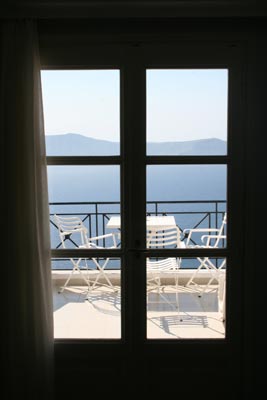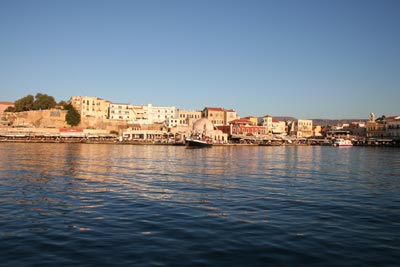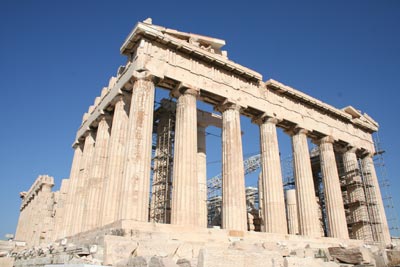A modern Greek odyssey
by Henry S. Lee, Houston, TX
My wife and I took a memorable 2-week Greek vacation in August ’07, spending four to five days each in Crete, Santorini and Athens. We traveled only to Greece because we had missed it on a previous trip and we wanted to focus on one country to experience it more in depth.
My wife and I are budget-conscious, independent travelers. As such, we take public transport, eat in low-key restaurants, shop for local groceries and visit neighborhoods not typically mentioned in tour books. One exception to this is our choice of lodging; we prefer higher-end rooms in which to unwind and be comfortable.
Crete
We started in Crete and found it to offer varied pursuits, from archaeological site visits and outdoor hiking to wine tasting. We based ourselves in Crete’s largest city, Heraklion, which had the trappings of a large town, including many restaurants, museums, outdoor markets and Orthodox churches.
We visited the large Minoan archaeological site at Knossos and the Boutari Winery at Skalani, both of which required a local bus ride (bus No. 2) from Heraklion’s bus station close to the port.
We took a one-way bus from Heraklion to Knossos and a one-way from Knossos to Skalani and planned to take a one-way back from Skalani to Heraklion, all of which cost a total of €6.20 ($9.60) for two. All of these routes are operated by local metro-type buses with ineffective air conditioning.
While Boutari is in Skalani, it is nowhere near the bus stop. In fact, bus route No. 2 ended at an intersection in what appeared to be a small residential neighborhood. Luckily, we tracked down a shopkeeper who showed us a “shortcut” to the winery, about a kilometer away. The “shortcut” took us away from the main road, through small trails around vineyards and past some small homes.
Boutari Winery is set on a very large tract of land along rolling hills. It is anchored by a modern visitor center where you can buy a tour, sample wine with crackers, etc., and, of course, buy wine to go. For the tour and a sampling of three additional wines not included in the tour, we paid €6 each. The tour made a quick stop in the actual vineyard, where we sampled the various grape types.
For someone planning a similar visit, I would advise taking a round-trip taxi from Knossos to Boutari. To avoid the uphill, kilometer-long hike back to the bus stop during the afternoon heat, we had the Boutari guide arrange a taxi to Knossos for us.
On to Santorini
Santorini strikes a balance between natural beauty and commercial development. In the town of Fira, we found jewelry and leather boutiques, T-shirt stands, souvlaki and gyro shops, dramatic beaches and wonderful sunsets and views.
Our hotel, Villa Renos (phone +30 22860 22848, www.villarenos.com), provided remarkable vantage points for enjoying the sunset. This 7-room, family-run hotel is managed by Vassilis, and the breakfasts, included in our room rate of €231, or $359, per night, were prepared by his parents. The fruits, vegetables and eggs were from their family farm, and the pastry spreads were homemade.
Our room, while fairly small and standard, was clean and comfortable. The highlight was the personal touch provided by Vassilis and his parents, who gave us local dining recommendations. One nearby place, Lucky’s Souvlaki, offered filling gyro souvlaki sandwiches for €1.50.
Villa Renos is located about a 10-minute walk from Fira’s bus station and about 30 steps down the hill from the main pedestrian walkway that borders the top of the cliffs. The hotels down this series of steps are not accessible by taxi. We saw some hotels farther down this path that were perhaps over a hundred steps away, so if your mobility is a bit limited, you should inquire about a hotel’s location and accessibility from the main road.
From our hotel room, we could see Santorini’s volcano top inside the caldera. There are many excursion options available to see the volcano, and we opted for the one that included a swim at the hot springs (€16, or $25, each).
We enjoyed the volcano but felt rushed, as we were allotted approximately an hour and a half to scurry to the top of the volcano and back down to our sailboat before heading out to the hot springs.
We would recommend skipping the hot springs. The water did not appear to be very clean and, due to the shallowness of the water, the excursion boats stopped about 30 meters short of the springs, requiring a swim and precluding nonswimmers from getting to the site.
Upon returning to the old port from the excursion, there were three options to get back up to the top of the caldera and the village of Fira: 1] taking a cable car (€4 per person), 2] riding a donkey up the stairs or 3] walking up the same set of stairs used by the donkeys (maybe 600 steps). We chose to take the donkeys and paid €5 per person, but others paid €4 per person the day prior, perhaps because of cruise ships tendering loads of tourists to the old port on the day we were there.
We traveled to Santorini primarily for relaxation and the views. As such, we sat on the beaches and took in every sunset, including one from Oia, a village about 25 minutes from Fira by bus. We paid €2.50 each for the round trip.
Many others had the same idea about traveling to Oia and returning immediately after sunset, so the 40- to 50-seat bus was crowded, with standing room only. Oia’s sunset was spectacular, and the effect of the setting rays on the primarily whitewashed stone facades of Oia’s buildings was no less dramatic.
Athens
In Athens, the sightseeing highlight was visiting the major archaeological sites, including the Acropolis, the Roman agora, the ancient agora, the Theater of Dionysus, the Temple of Olympian Zeus, Keramikos (a cemetery) and the Theater of Herodes Atticus.
We purchased a combination ticket (€12, or $18.50) which provided access to all of these sites except Herodes Atticus, which is open only during live performances. However, we were able to stop and enjoy a view of the theater as we wound our way up the Acropolis from its northern entrance.
The combination ticket can be purchased from any of the six sites. Of those, we enjoyed the ancient agora the most as it was the best preserved, with a comprehensive museum and little ongoing renovation work. We skipped Keramikos since we could basically see the rows of ruins from the elevated street level.
While the major sites are located in a fairly compact area, we opted to buy the weekly public transport pass (€10 per person), entitling us to travel on the subway (which we used for multiple trips to the grocery store and sites), the tram (for a trip to the beachfront), trolley buses (to Panathinaiko Stadium) and blue buses (to Athens’ Bus Terminal B). We saved immeasurable time and gained convenience by not having to gather change and buy and validate tickets every time we stepped onto public transport.
Delphi day trip
As for the buses to Terminal B, we took No. 24 from Amalias Avenue, just west of the National Garden, to Terminal B to take a regional bus on a day trip to Delphi. Terminal B, on the Praktoria stop, is located off the bus route in a fairly nondescript group of buildings. We had the good fortune of finding a local who discerned that we were looking for Terminal B and alerted us as we arrived at the Praktoria stop.
Delphi is very much worth a visit, but be sure to plan enough time to visit the Sanctuary of Apollo, the Sanctuary of Athena Pronaia, the old gymnasium and the Delphi museum. We took the second scheduled bus of the day from Athens and had only about 2½ hours to see Delphi. (We had to skip the museum.) Add the fact that the Delphi bus stop is about one kilometer (including hills) from the sanctuaries, and we felt rushed on our visit.
If you are planning a day trip, I’d recommend taking the very first bus of the day (7:30) from Athens to Delphi (€13 per person, one way) and the next-to-the-last bus on the return (departing at 4:00). I would advise against taking the last bus back to Athens in case it gets canceled unexpectedly. I’d also suggest buying your return ticket immediately upon arrival in Delphi.
The trip takes about three hours each way, with a stop at a small hotel just east of Livadia for a short break.
Final thoughts
As for general observations about travel in Greece, I would recommend having plenty of cash on hand. Lodging aside, plan on about 65% of your expenditures to be in cash, as many sites, shops and restaurants do not accept credit cards.
If you plan on significant walking, wear closed-toe shoes. (My wife packed just a pair of sandals for the entire trip.) The rocky paths and uneven terrain and simply the amount of walking exposes you to unintentionally stubbing your toes if they are not protected.
Lastly, use plenty of sunscreen and lip balm for protection.
Doing these few simple things will make your trip much more enjoyable.




